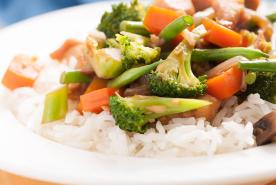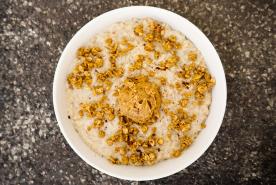Switching to a plant-based eating by focusing on fruits, veggies, and legumes. Swap animal proteins for plant options and monitor sodium and potassium.
By Gretchen Wiese, RD and Kathleen Hill Gallant, PhD, RD
Why start a plant-based diet?
A plant-based diet includes eating more plant foods like whole grains, fruits, vegetables, nuts, legumes (beans, peas, and lentils), and healthy plant oils (such as olive or canola) and less animal foods like dairy, eggs, fish, and meat. Growing evidence shows that plant-based diets may help prevent health problems like heart disease and further kidney damage in people with kidney disease. Some studies say that people living with kidney disease who followed a plant-based diet lived longer than those whose diets were more animal-based. However, starting a plant-based diet does not mean that you need to become a vegetarian and cut all sources of animal protein from your diet. One study has shown that swapping out animal protein with plant protein at two out of three meals per day may be enough to provide health benefits of a plant-based diet in patients with chronic kidney disease.
Tips for starting a plant-based diet
Like all lifestyle changes, it is important to start slowly. Try making one change at a time and build up to your goal. Be sure to let your doctor know you are interested in making a shift to a plant-based diet. A registered dietitian can help guide you through diet changes that work best for your individual needs.
Some starting steps:
- Replace animal sources of protein (beef, fish, dairy) with plant sources of protein (legumes, nuts, soy, tofu, or grains) at a meal or snack.
- Replace more processed grain products with whole grain products.
- Keep track of the calories and protein you eat daily to make sure you are meeting your needs.
What to look for on the nutrition facts label
There are a few things to watch out for when following a plant-based diet with kidney disease:
- Serving Sizes: We tend to eat more than one serving of many food. Pay attention to the amount of protein, calories, and important minerals (like sodium and potassium) per serving of a food product.
- Sodium and Potassium: Some minerals may be out of balance in your body due to lower kidney function. Pay attention to the amount of potassium and sodium on the nutrition label. Large amounts of potassium can be found in some fruits, vegetables, legumes, and nuts. Large amounts of sodium can be found in some soy-based or other plant-based meat substitutes (such as soy-based burgers, hot dogs, or deli meats).
Typical Serving Sizes of Plant Protein
Listed below are sources of plant protein that you can start to include in your diet:
- ½ cup of cooked beans (6-15 g protein)
- ¼ cup of nuts (8 g protein)
- 2 tablespoons nut butter/spread (8 g protein)
- ½ cup of cooked brown rice/noodles (4-7 g protein)
- 1 slice of whole grain bread (5 g protein)
- 1 unit of a soy-based meat alternative (example, 1 soy-burger patty) (10-20 g protein)
Protein swap-outs
Below are some ideas for swapping sources of animal protein for plant protein:
Hamburger patty (3.5 oz.)
175
Soy burger patty (3.5 oz.)
120
16
1 Hardboiled egg
78
1/4 cup almonds
207
8
2 tablespoons cream cheese
100
2 tablespoons peanut butter
188
8
Atlantic Cod (3.5 oz.)
82
Tofu, firm (3 oz.)
70
11

















